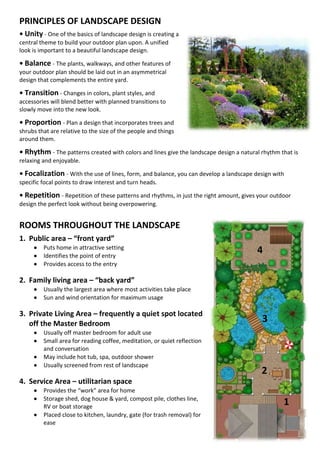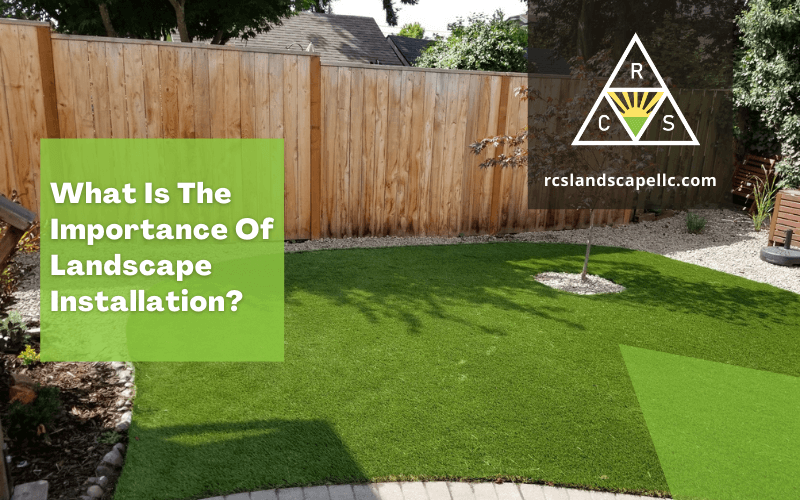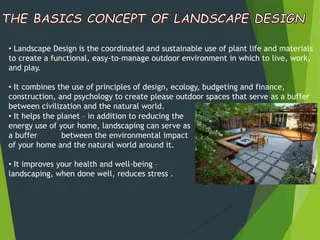Our Landscape Design Diaries
Our Landscape Design Diaries
Blog Article
Our Landscape Design Diaries
Table of ContentsThe 15-Second Trick For Landscape DesignOur Landscape Design StatementsEverything about Landscape DesignAll About Landscape Design
When developing a residential landscape, one of the most crucial step is to put an intend on paper. Creating a plan of attack will save you money and time and is much more likely to result in an effective style. A plan of attack is established through the 'layout procedure': a step-by-step approach that considers the ecological conditions, your wishes, and the aspects and concepts of layout.The 5 actions of the layout process consist of: 1) performing a website stock and analysis, 2) determining your requirements, 3) producing practical representations, 4) developing conceptual layout strategies, and 5) drawing a final design strategy. The initial three steps develop the visual, useful, and horticultural needs for the design. The last 2 steps after that apply those demands to the development of the last landscape strategy.
This is a crucial action for both plant option and positioning and locating family members activities and features. It is essential because the exact same climate problems that influence the plantstemperature, humidity, rain, wind, and sunlightalso affect you, the user. The following step is to make a checklist of your needs and desiresthis helps you determine exactly how your lawn and landscape will be made use of.
The practical representation is after that utilized to situate the activity rooms on the site and from this diagram a conceptual strategy is created. The last action is a last layout that consists of all the hardscape and growing information that are required for installment. Throughout the layout procedure there are ten essential things to think about: for plant option and task area by considering what you desire and require to aid identify shapes and organize spaces by designating task areas and linking with elements for both the atmosphere and the individual by utilizing massing and layering techniques such as transition areas and prime focus in the products, the shades, and the surface area appearances for the growth and upkeep of plants by making use of lasting style methods A thorough inventory and analysis of the website is very important to figure out the ecological conditions for plant development and the very best use the site.
6 Simple Techniques For Landscape Design
It is constantly best to use plants that will certainly flourish in the existing dirt. Where plants expand well, keep in mind the dirt problems and utilize plants with similar growing needs.

Sun/shade patterns, the quantity and length of exposure to sunlight or color (Figure 1), create microclimates (occasionally called microhabitats) - Landscape Design. Recording site problems and existing greenery on a base map will certainly expose the area of microclimates in the yard. Plants generally fall under a couple of of four microclimate categories-full sun, partial color, color, and deep color
The Only Guide for Landscape Design
Figure 1. Sun and shade patterns. Credit Score: Gail Hansen, UF/IFAS It is important to keep in mind all the current problems on a precise base map when doing the website inventory (Figure 2). Utilities such as power lines, septic systems, underground utilities and roofing system overhangs figure out plant area. Recommended Site Utilize a land surveyor's plat of your residential property for the borders and location of your home.


Figure out the time and money you are ready to place into keeping the plants and hardscape-be realistic about your intentions and ability. Recommended usage areas. Credit Report: Gail Hansen, UF/IFAS There are many various landscape style themes- from easy to complicated, but it is practical to choose one to assist your plant and product selection.
Lots of people discover it handy to look in gardening publications and publications for concepts. This is a good begin, yet know that the gardens in the pictures were chosen due to the fact that they are impressive instances. Take a look at the pictures with an essential eye to gather ideas that you can adapt to your interest level, your budget and your website.
Make a decision if you intend to open your lawn, close your backyard, or a little of both, to these sights (Landscape Design). Simply put, do you desire the garden to confine the area around you and connect primarily to your house, or do you desire the yard to open sights and look outside, associating to the surroundings? This will certainly offer you a beginning point to think of a style
Everything about Landscape Design
Every garden ought to have a kind style, however not all yards have a style motif. Numerous domestic yards have no certain style except to mix with the residence by repeating information from the architecture such as products, check out this site shade, and type.
In a form style the company and shape of the rooms his response in the backyard is based either on the shape of your house, the shape of the areas in between your home and the residential property boundaries, or a preferred form of the property owner. The type motif establishes the shape and organization (the design) of the rooms and the links between them.

Report this page